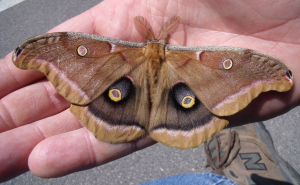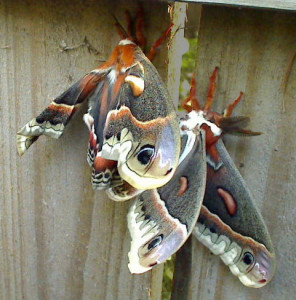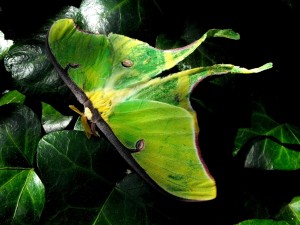
Within the natural world there are many spectacular things. But none more spectacular than to find the ethereal Luna moth or the massive Cecrcopia or Polyphemus moth. Theses giant moths can have a wing span of up to six inches or more. Not only are the adults spectacular, but so are the caterpillars. Some get to be the size of a fat Cuban cigar.

Moths are one of the most diverse and plentiful groups of insects in Ohio, and the world. An estimated 160,000 species have thus far been catalogued worldwide, and about 13,000 species have been found in North America. It is estimated that Ohio has around 3,000 species of moths, but the number is climbing as more research and identification is done. Moths are extremely important part of the natural world and are commonly overlooked because they are mainly active during the night. Adult moths serve as food for many predators, perhaps most notably bats, and a number of birds. Many species of songbirds feed on adult moths. Several species of birds would perish without moth caterpillars to feed their young. Moths also serve as a major food source for many species of spiders. With bees getting all the credit; moths, as well as bats, may be more effective in pollinating many species of plants. Some species of plants, especially in the Orchid family, have co-evolved with certain moths and can only be pollinated by moths. Typical moth-pollinated plants have pale or white flowers and emit a fragrance at night. Some moth-adapted plants, such as evening primroses, only open their flowers after dark when their moth pollinators become active.

The largest moths of temperate North America are known as Giant Silk Moths, family Saturniidae. There are 10 species in Canada and the United States and they are aply named due to the fine silk they use to spin their cocoons which serve as protection for the pupal stage in their life cycle. The commercial “silkworm” moth (Bombyx mori) is from a different family and are not even closely related. These moths emerge from their cocoons in June in what are knowns as flights. Silk moths live only long enough to mate and lay eggs and then die. They have only rudimentary mouth parts and eat nothing during their short lives. The eggs are laid on a host plant and hatch out in a few weeks into the caterpillar form. After feeding and growing for a few weeks, they spin silky cocoons on twigs and spend the winter maturing and waiting for the flight in spring. Mortality rates are often high due to predation by woodpeckers, and others, who know that a tasty treat lays inside this large cocoon. Adults emerge from their cocoons in daytime, usually around mid-morning. This means they have the warmth of the day to inflate and dry their wings in preparation for the evening’s flight. When darkness falls the fun begins. Adult silk moths have no working mouth parts. They do not feed or drink and will only live for one to two weeks after emerging from their cocoons. Male moths locate the females by scent. Females emit strong pheromones and wait for the males to find them. The males’ large comb-like antennae can detect the pheromone at minute concentrations. Once a female has mated she takes flight, seeking out the appropriate plant species on which to deposit her eggs. Silk moth caterpillars, like those of most other butterflies and moths are adapted to feed on the leaves of only a few specific kinds of plants. Willow, Black Cherry, Oak, Maple, Tulip Poplar, and Birch are some of the preferred host plants for the silk moth caterpillars to feast. Females can lay more than 100 eggs, but usually only place a few on any one suitable plant. Thus, the cycle begins again, bringing joy and wonder to those lucky enough to find these magnificent insects. So, some warm night in the near future, go out into nearby nature and see what you can find!
More Nearby Nature
June 27th – Moths of the Night – Towner’s Woods 8:30-10:00
Come join Portage Park District volunteer naturalist Joe Malmisur and others as we use black lights and white sheets to attract moths and other night insects for identification. Who knows what we will see, maybe a spectacular Luna or Promethean moth. We will also be hiking a few trails in search of a Barred or Great Horned Owl. WHOOOO knows what we will see or hear!











